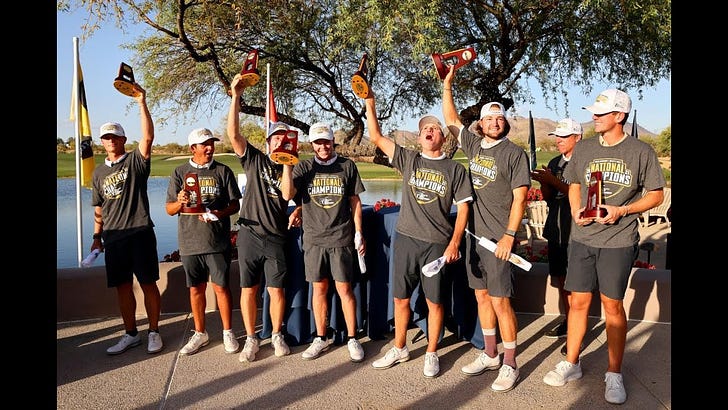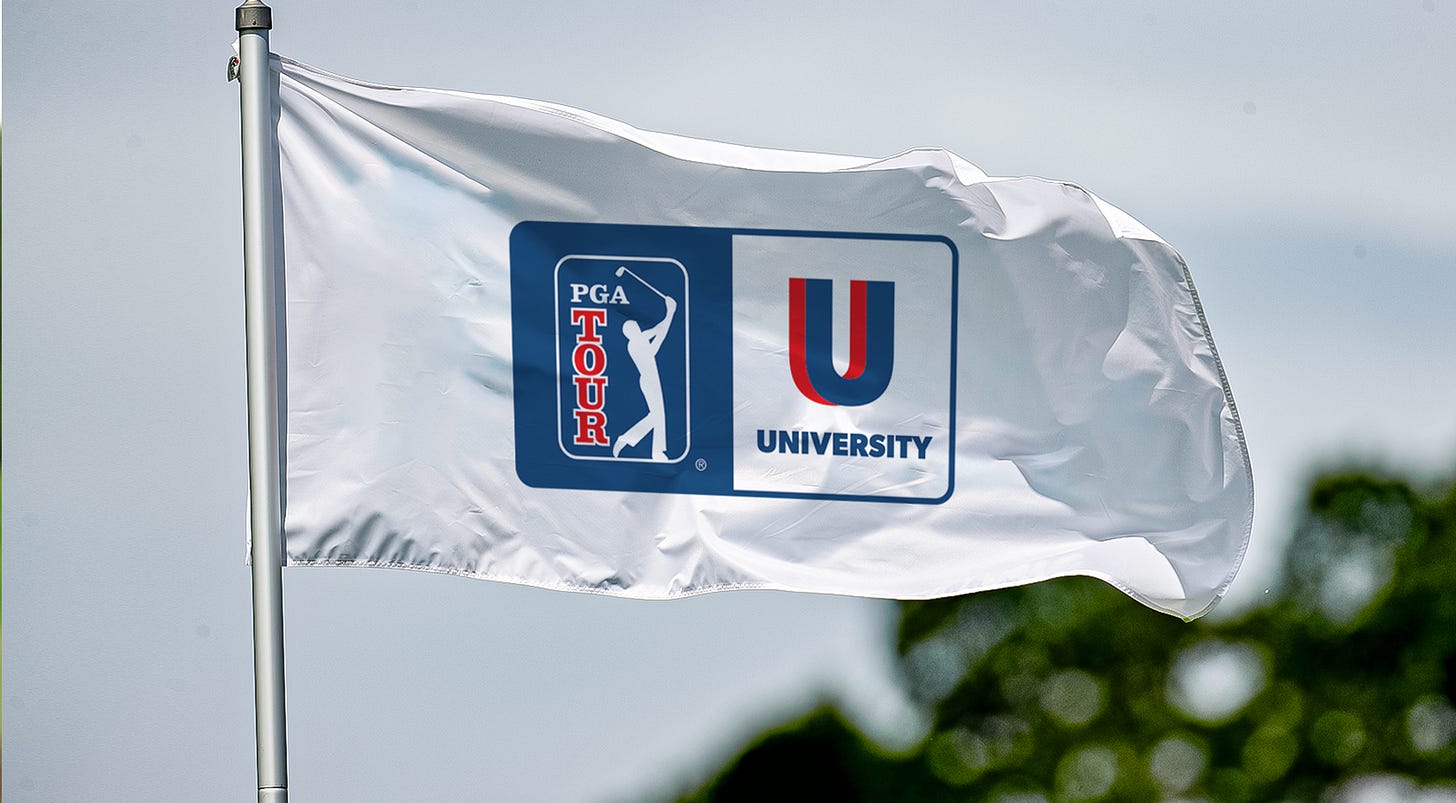This is part of a series on the Men’s Collegiate Championships
NCAA Championship Era: 1939-NOW
EXTRA HOLES EVENT CANCELLED: The Quarantined Season
The 2019-2020 season was going incredibly well until suddenly it wasn’t. Unlike every other season for the last 100 years, this year ended without a national champion. The whole world had come to a screeching halt as the coronavirus pandemic swept across the globe, disrupting every normal activity imaginable and sending home to hunker down and wait to see what happened. Once the first major sport decided to cancel their season, everyone else soon followed suit, fearing backlash from not deciding quick enough to release their “...in these unprecedented times” email in the interest of public safety. College golf teams that were just gearing up for the Spring sprint towards the championship were shut down, in some cases pulled out of the middle of a tournament so they could be rushed back to home/school/wherever they could quarantine. The end to the season was jarring in a way that this author can’t effectively describe. Teams like Pepperdine - recognized as the deepest in the country and primed for a championship run - went from enjoying the second act of their own sports movie to having the projector turned off, the house lights forcefully brightened, and unceremoniously booted off the property. You don’t have to go home but you can’t stay in public.
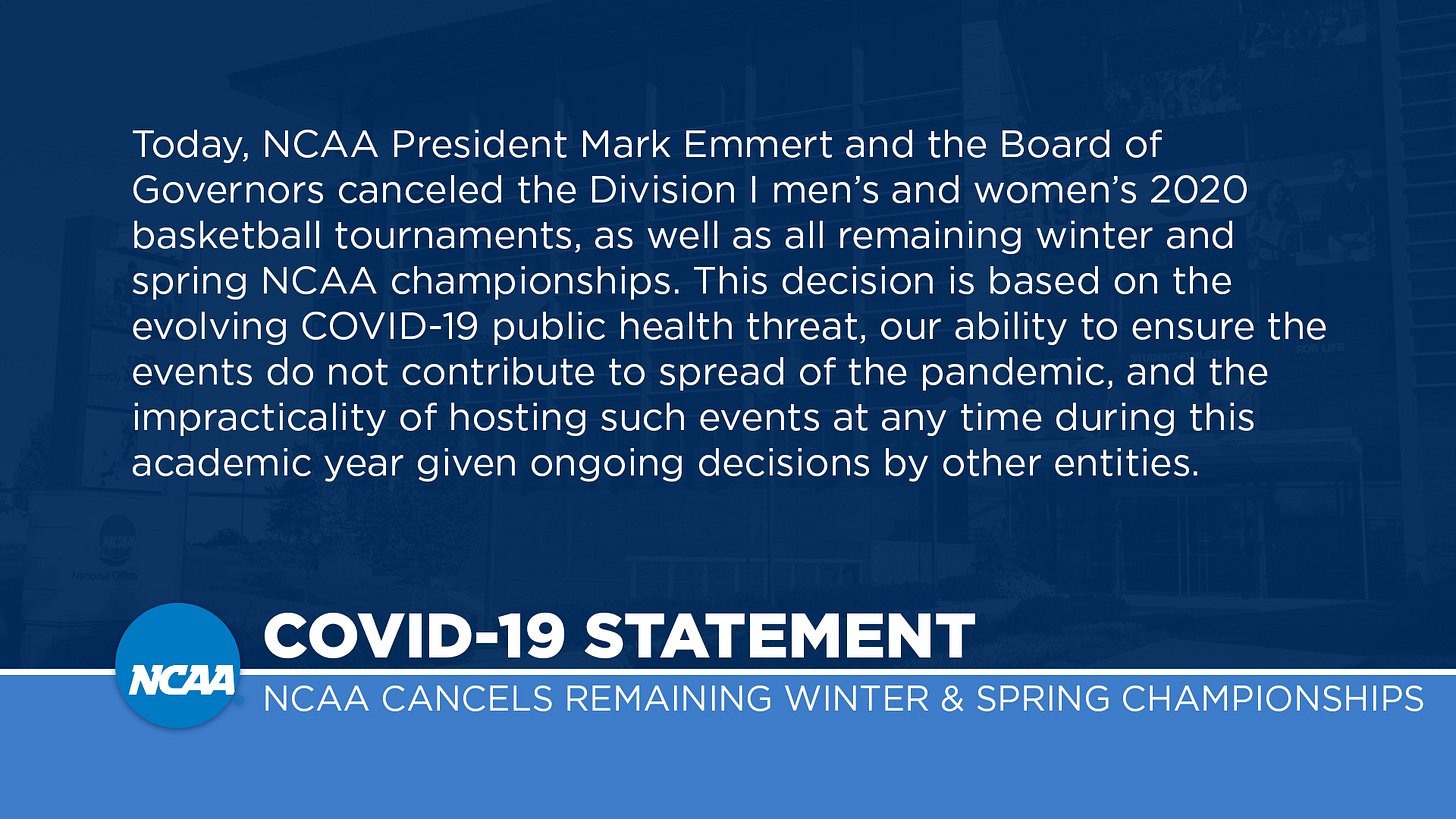
2021: The Return
Nothing was the same, and yet everything tried to be. Golf was back by the Fall of 2020, or in some cases at least Spring of 2021. The world was still in the midst of various health safety procedures as everyone tried to acclimate to the weird hybrid reality of the be-cautious and get-back-to-normal. The “new normal” was a phrase batted around so often that some actually reflected fondly on the “...in these unprecedented times” emails that could at least be deleted without much thought. Don’t get us wrong, this was a serious situation. People had died, were dying still, but as time passes and we get further away from those unprecedented times it’s hard to understand just how surreal the entire thing was. In any case, we’re here to talk about golf, and it was BACK! But how would teams respond?
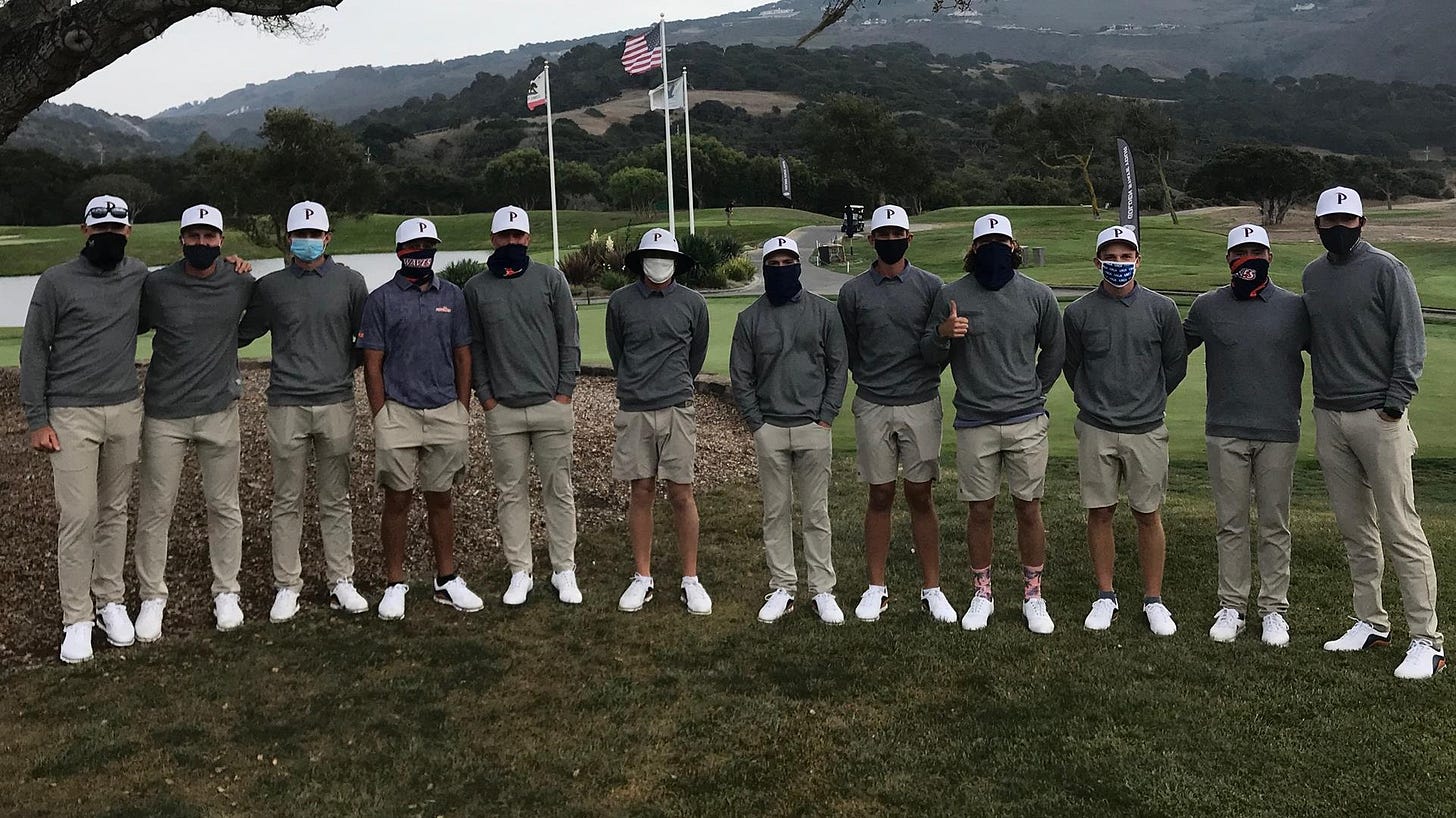
REGIONAL ROUND-UP
Watch the entire Regional selection show that helps give context to the whole season:
STILLWATER REGIONAL
Oklahoma State thrived at home to win their record 5th straight Regional title. Auburn and Baylor both shot double-digit over par on the final day and ended up falling on the wrong side of the cutline by a single stroke. Little Rock becomes the first 9th seed to advance since moving to the current format in 2009. The biggest storyline was undoubtedly the incredible final day from the four Sam Houston players who had to continue on without top player, William Holcomb, who was sidelined due to Covid-19 protocols. Without the safety net of a drop score, Sam Houston persevered to make it to Nationals for the first time.
NOBLESVILLE REGIONAL
Texas earns their 3rd straight Regional title (5th of the last 6th championships). UAB shoots a tournament low 13-under-par 275 on the final day to jump North Florida for the final qualifying spot.
TALLAHASSEE REGIONAL
Florida State runs away at home for their first ever Regional title. The rest of the results were pretty chalky with the exception of TCU who jumped over Ohio State to capture the final advancing spot.
KINGSTON REGIONAL
The Tennessee regional ended about as expected when it comes to the seeding, just not in the order they were seeded. Vanderbilt pulled away from the field on the final day to win their first ever Regional title.
CLE ELUM REGIONAL
ETSU joins Sam Houston as the first 8 seeds to advance to the NCAA tournament since before 2009. Although they had a great run from 1989 (beginning of Regionals) to the mid 2000s, this was ETSU’s first trip back to the Nationals since 2008 and only their second victory (2001). Sacramento State was another casualty of the Covid-19 protocols and forced to withdraw before the final round. Even though they didn’t look likely to advance, it was still an incredibly difficult way to end the season.
ALBUQUERQUE REGIONAL
It took a double-digit under-par final day for the top ranked Oklahoma to push their way into qualifying for Nationals. Texas Tech had the low round of the tournament to jump over Arizona State for their first team Regional title since 2010. The 11th seeded San Diego has a massive day to beat out Texas A&M (3 seed) and New Mexico (5 seed) for the final advancing spot.
Intercollegiate Championship #123: May 28 - June 2, 2021
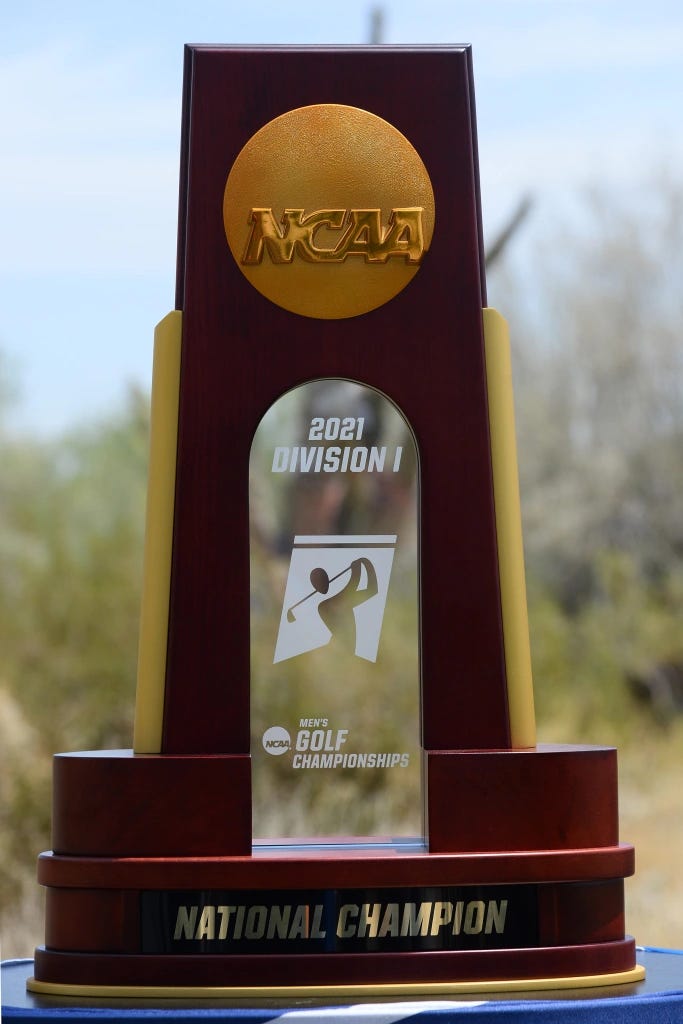
Host: Grayhawk GC (Arizona State)
Starting in 2015, the men’s and women’s NCAA Golf Championships were held at the same location just a week apart to help facilitate TV coverage by the Golf Channel. In 2017, the NCAA golf committee put into motion a plan to provide more stability to the championships by having one site host three years in a row. Since one of the hopes was to avoid major weather pitfalls, the first site to try this experiment was likely going to be one in a warm climate. Grayhawk Golf Club, home course for Arizona State, is a top course in a prime location, making for a great place to host the 2020-2022 championships. With the first year cancelled, that three-year window shifted to 2021-2023.
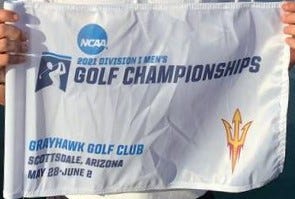
Format
Team and Individual stroke play
Day 1 (Friday) = 18 holes
Day 2 (Saturday) = 18 holes
Day 3 (Sunday) = 18 holes
**Cut to top 15 teams
Day 4 (Monday) = 18 holes
**72 holes determines Individual championship
**Cut to top 8 teams
Team match play
Day 4 (Tuesday) = 2 matches
Quarterfinals
Semifinals
Day 5 (Wednesday) = Finals
Results
Individual Medalist/Champ: Turk Pettit [Clemson]
For three rounds Oklahoma State’s Bo Jin was in control. Jin went 67-65-69 to sit atop the field at 9-under par (201). Two shots behind Jin sat Clemson’s Turk Pettit who was playing incredibly steady golf. Because of the difference in how their two respective teams stood, these guys went off different sides of the course so that Pettit was finishing on hole #9 and Jin on #18. A significant swing hole for both players was #17 (Pettit’s 8th of the day), where both players drove the green on the par 4 but Pettit two-putted for a birdie that gave him his first lead while a couple hours later Jin three-putted for a disappointing par that would have given him back the lead late. Pettit was able to make a great up and down on hole #9 in time to catch Jin make his way down 18. After pulling his drive into the left rough, Jin’s approach shot barely cleared the water short-right of the green. From there it took him three shots to hole out which gave Pettit the title by a single stroke. Although the Clemson team wasn’t able to advance into the match play portion, Pettit’s win sent Coach Larry Penley into retirement in style with one more lacquered piece of hardware. Watch the full replay below:

(via GolfStat) 
(via Clemson Athletics)
Team Stroke Play:
Grayhawk proved to be an interesting challenge across the board. Through three rounds, only Oklahoma State was under par, enjoying a 13 stroke lead over rival Oklahoma who was sitting at 1 over par. After the third round finished, Georgia Tech and TCU both stood at 32 over par, necessitating a sudden-death playoff for the 15th spot to play the fourth round of stroke play, which Georgia Tech won. Most of the drama for the final round of stroke play came not from who might play their way into match play but rather who might play their way out. Despite double-digit over par scores, Vanderbilt and North Carolina were able to halt their drop right at the 8 team cut line. Wake Forest had started the day tied with Vandy and UNC at T6 but a disastrous 303 (+26) took them way out of the running. Pepperdine on the other hand had started just one stroke back of that group and posted an incredible tournament-low 271 (-9) to vault them all the way up to 3rd. Oklahoma State clearly let off the gas for the final round, knowing they had plenty of strokes to spare to still make match play. As Arizona State made their way up the leaderboard with the only other under-par day, it’s fun to speculate that maybe Oklahoma State took a pass on the top seed considering their 2018 “Team of Destiny” was still the only match play #1 seed to win the championship. Watch the full replay above!
Team Match Play:
Quarterfinals
Oklahoma State continued their solid play across the board, controlling a majority of their matches against Vanderbilt. Florida State was able to keep it close in two of their biggest matches, but the other three got away from them as Pepperdine showed off their depth and won convincingly. Similar to the FSU/Pepperdine matchup, North Carolina was able to keep it close with their top matches but ultimately succumbed to the home team, Arizona State, playing solid golf. Illinois won two convincing matches, but Oklahoma got the decisive points with their star transfer, Johnathan Brightwell, leading the way. Watch the full replay below:
Semifinals
The Pepperdine / Oklahoma State match was hotly contested in each of the matches, but all of them worked out for the Waves. Once again Clay Feagler got Pepperdine’s first point - this time with a hole-in-one which changed the dynamic of his match - and the clenching point came from Joe Highsmith. The #1 seed curse was not broke with Oklahoma State’s 2018 victory from that position, and it continued here with Arizona State falling to Oklahoma. The first four matches were split, but Oklahoma’s Quade Cummins seemed ready to roll the Sooners right into the championship. With his (and his team’s) back against the wall, ASU’s Cameron Sisk made a valiant comeback attempt but it proved too little too late. With that the Finals were set. Watch the full replay below:
Finals: Pepperdine (2 NCAA, 2 overall)
Pepperdine’s Dylan Menante, a notoriously fast player, got off to an equally fast start and combined with teammate Joe Highsmith also building a quick lead in the second match, it seemed like Pepperdine might just run away with the title. The last three matches, however, all played close for a good portion of their respective match. Incredibly, Logan McAllister got his second hole-in-one of the tournament (5th hole in the final round of stroke play) when he aced the 8th hole to increase his lead to 2. From that moment on, the energy for all of the matches seemed to have somehow ratcheted up even higher. As players made the turn, the score stood as each team with a match they felt good about closing out but the other three were completely up in the air. Highsmith ended up closing out his match strong as did William Mouw, giving Pepperdine two crucial points. Oklahoma’s transfer senior showed his maturity in hanging with Menante and eventually flipping that match for an unlikely point. Fittingly, the final point for Pepperdine came from senior Clay Feagler who had struggled through the year but was there posting scores when his team needed him the most. In the end, the Pepperdine Waves, who won their second championship ever (1997) seemed not only like a worthy champion but perhaps also as the right champion considering it very easily could have been their second championship in a row if things had not gone so horribly wrong the year prior. Watch the full replay below:
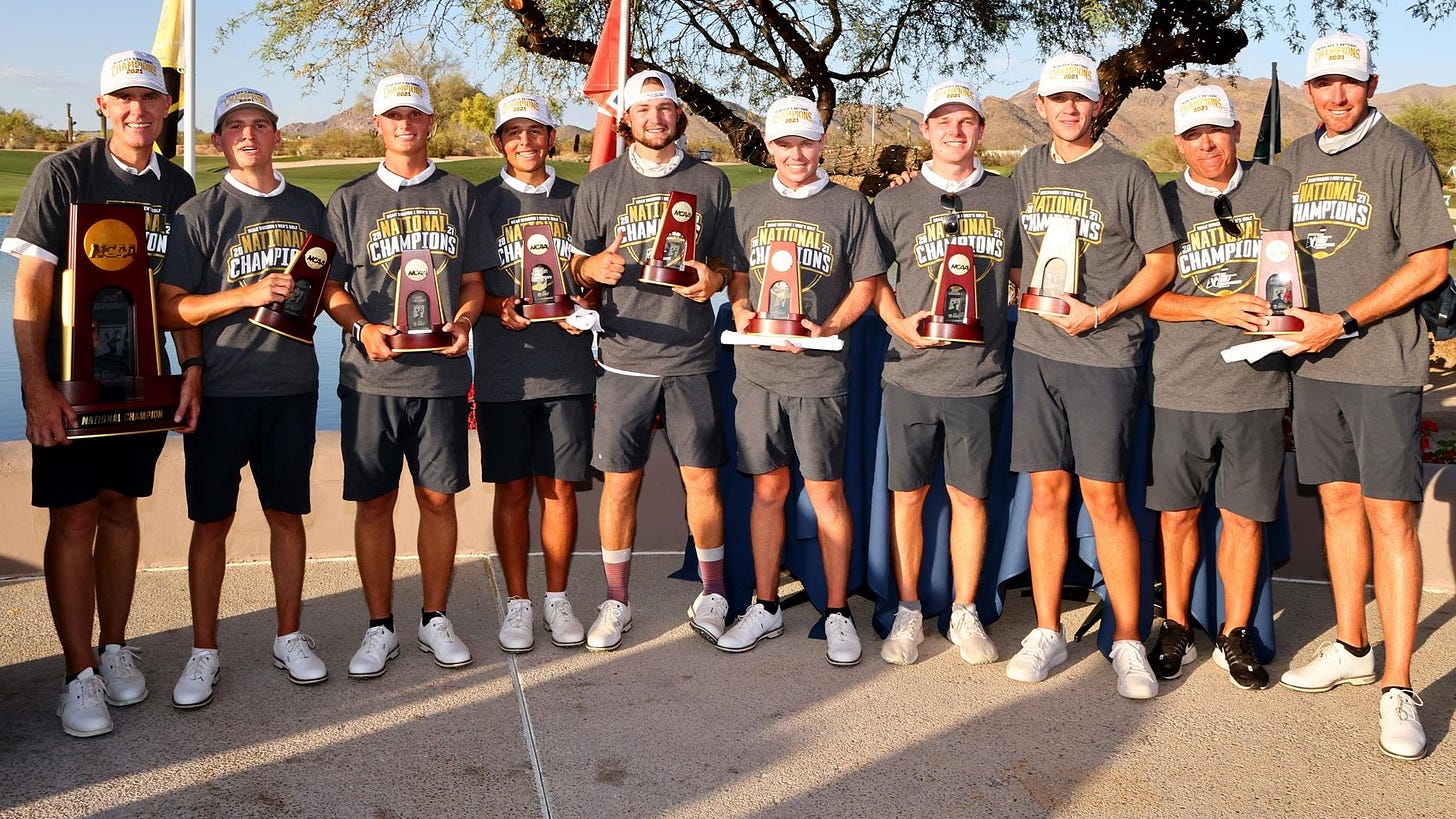
(NCAA Photos via Pepperdine Athletics)
EXTRA HOLES: PGA Tour University
Despite everything being shut down for the season, the PGA tour made a very interesting announcement in June, 2020, regarding a new pipeline for getting the best college stars into the pro ranks: PGA Tour University. For the first time, college seniors were being rewarded for their combined collegiate and pro (exclusively PGA Tour and Korn Ferry Tour) play in a way that would directly impact their pro careers. Before - and still an option - players coming out of college had to go through the typical route of earning status on one of the “feeder tours” such as the Korn Ferry Tour to eventually earn status on the PGA Tour, or else navigate the complicated process of turning sponsor exemptions into full status with stellar play: aka the Jordan Spieth route. Now, players are offered an incentive to stay through their senior year in college in order to gain points for their finishes in qualifying events, with those earning the best average getting an extra leg up towards potential long-term success on the pro tour. It’s a fast pass for golf, if you will. This FAQ helps sort out some of the finer points. At the conclusion of the 2021 championship, the first ever graduates of PGA Tour U were announce and awarded their prizes.
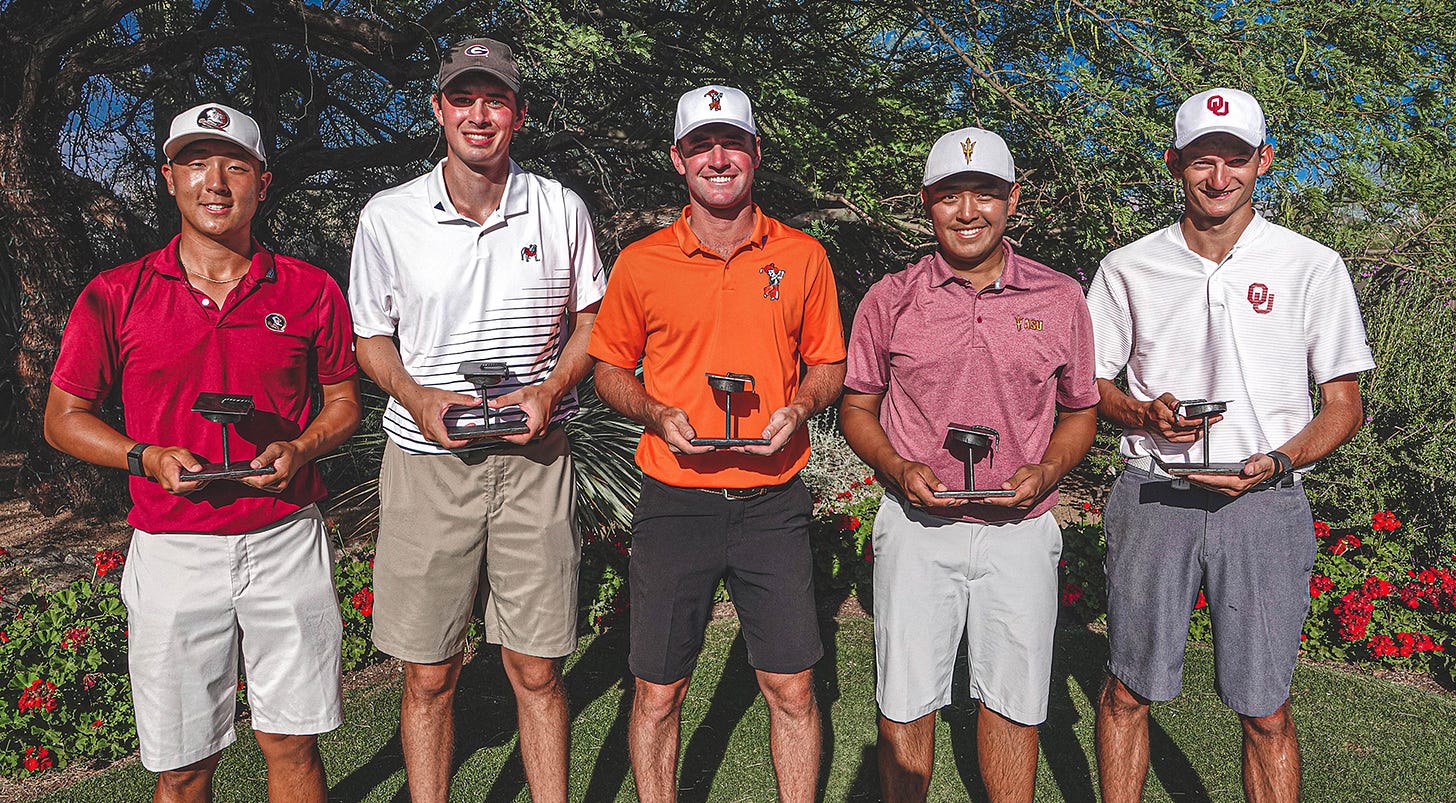
Several alterations have been made since that first season, most centered around dialing in the points distribution for each of the tournaments to more accurately reward players for finishing higher in tougher fields. Other changes revolved around how best to reward a player competing in a pro event without making it too advantageous to go miss the cut at one of those events versus placing in the top of a collegiate event. It’s a careful balancing act that continues to go through tweaks. The biggest change of them all is the increasing reward for finishing at the top of the PGATU class. By 2023 the prize for finishing 1st in the PGATU rankings had escalated all the way to a multi-year PGA Tour exemption, while those finishing in the top 15-20 were also awarded coveted exemptions into other pro tours such as the Korn Ferry Tour and various international PGA Tour affiliates.

The 2022-23 season also brought with it an exciting announcement regarding the PGATU Accelerated Program. Although college seniors were the only ones in the running for the aforementioned PGATU race, now underclassmen who were excelling would have an opportunity to earn a PGA Tour card before their senior year. Essentially, major milestones given point values and a point threshold was established which, if reached before the player’s 4th collegiate year, would earn them a PGA Tour card which was waiting for them whenever they left college. This setup established a direct pipeline to the top pro tour for the young phenom-type players that in the past had sometimes been caught up in the brutal grid between collegiate golf and the PGA Tour. The added bonus of the card being available after college, even if it took a year or more to complete, encouraged those players to continue their studies and mature as both people and players before joining the pro ranks. The hope being that it would give the best possible opportunity for lasting success and not a quick burnout. The points breakdown and additional details can be found here.
Thanks for reading!
Up Next:
In the next post we will cover. . . something else. Since this concludes our men’s championship series, we’re going to take the opportunity to explore a few one-off topics before jumping into our next series.

